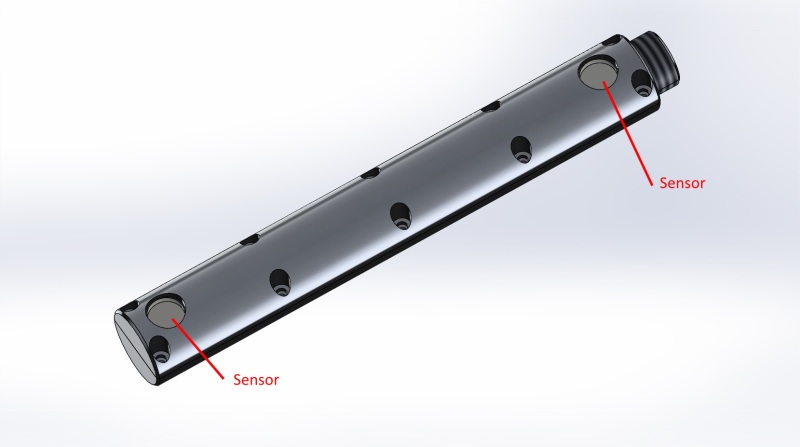amrbekhit
Electrical
- Mar 20, 2008
- 30
Hello all,
We've got an issue whereby a stainless steel pressure sensor housed in an aluminium or zinc enclosure and submerged in a static tank of tap water starts to drift (i.e. the pressure reading starts to continuously increase or decrease away from its nominal value). Other than a small amount of evaporation, the liquid level in the tank is fixed. The amount of drift is way too high to be explained by evaporation.
Here's a couple of simplified images showing generally how the item is assembled. The sensor are pushed into suitably sized holes in either a machined aluminium or die cast zinc cylindrical housing composed of two halves. for the test units, they are held in place simply using the friction between their O-ring (not shown) and the hole. Openings in the housing allow fluid to reach the sensor diaphragm.


We have observed the following:
- If the sensors are submerged in water in a plastic enclosure, we do not see this phenomenon.
- The drift happens a lot faster with the zinc housing than the aluminium one (zinc versions might drift within 24 hours, aluminium version might drift after a week).
- We don't believe the issue is related to the electronics or software. If we take a drifted sensor out and check its readings using the manufacturer provided hardware/software, we can see that the sensor has indeed drifted. It appears that there is a physical change to the sensor's properties.
- If you take a sensor that has drifted out of the water and leave it in air, it gradually drifts back to its nominal value over many many days.
- We have not observed this drift when the sensors are submerged in oils (e.g. kerosene, diesel).
- There is no liquid ingress inside the enclosure.
- The drift often affects only one of the sensors - the other one continues to operate without problem. With the zinc enclosures, it is mostly the bottom sensor that drifts. With the aluminium enclosure, it is mostly the top sensor.
- A new sensor starts off with a clean, mirror-like diaphragm. After being submerged for several days, the sensor becomes cloudy and is covered in a thin white substance. There is more white substance on the drifting sensor than the non-drifting one. (see photo below showing an affected sensor
We've got an issue whereby a stainless steel pressure sensor housed in an aluminium or zinc enclosure and submerged in a static tank of tap water starts to drift (i.e. the pressure reading starts to continuously increase or decrease away from its nominal value). Other than a small amount of evaporation, the liquid level in the tank is fixed. The amount of drift is way too high to be explained by evaporation.
Here's a couple of simplified images showing generally how the item is assembled. The sensor are pushed into suitably sized holes in either a machined aluminium or die cast zinc cylindrical housing composed of two halves. for the test units, they are held in place simply using the friction between their O-ring (not shown) and the hole. Openings in the housing allow fluid to reach the sensor diaphragm.


We have observed the following:
- If the sensors are submerged in water in a plastic enclosure, we do not see this phenomenon.
- The drift happens a lot faster with the zinc housing than the aluminium one (zinc versions might drift within 24 hours, aluminium version might drift after a week).
- We don't believe the issue is related to the electronics or software. If we take a drifted sensor out and check its readings using the manufacturer provided hardware/software, we can see that the sensor has indeed drifted. It appears that there is a physical change to the sensor's properties.
- If you take a sensor that has drifted out of the water and leave it in air, it gradually drifts back to its nominal value over many many days.
- We have not observed this drift when the sensors are submerged in oils (e.g. kerosene, diesel).
- There is no liquid ingress inside the enclosure.
- The drift often affects only one of the sensors - the other one continues to operate without problem. With the zinc enclosures, it is mostly the bottom sensor that drifts. With the aluminium enclosure, it is mostly the top sensor.
- A new sensor starts off with a clean, mirror-like diaphragm. After being submerged for several days, the sensor becomes cloudy and is covered in a thin white substance. There is more white substance on the drifting sensor than the non-drifting one. (see photo below showing an affected sensor
and a new one
).

This problem has baffled us for some time. The only possible explanation that we could come up with is that galvanic corrosion is occurring between the stainless steel sensor and the aluminium/zinc housing, with aluminium/zinc oxide being deposited on the sensor diaphragm and thus changing its properties. However, we can't explain why leaving it in air causes the sensor to slowly drift back to its nominal value. We would have expected the drift to simply stop when the sensors are removed from water. We also can't explain why it only happens to one of the sensors and not the other.
Any thoughts?
Thanks,
Amr

This problem has baffled us for some time. The only possible explanation that we could come up with is that galvanic corrosion is occurring between the stainless steel sensor and the aluminium/zinc housing, with aluminium/zinc oxide being deposited on the sensor diaphragm and thus changing its properties. However, we can't explain why leaving it in air causes the sensor to slowly drift back to its nominal value. We would have expected the drift to simply stop when the sensors are removed from water. We also can't explain why it only happens to one of the sensors and not the other.
Any thoughts?
Thanks,
Amr
